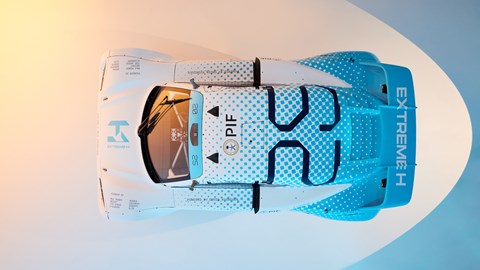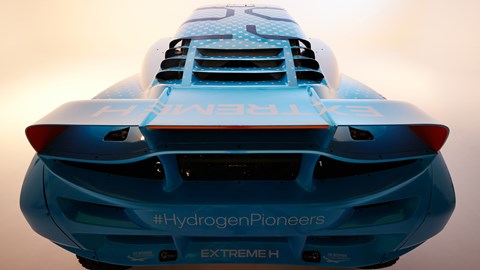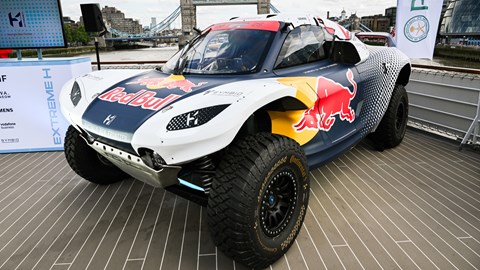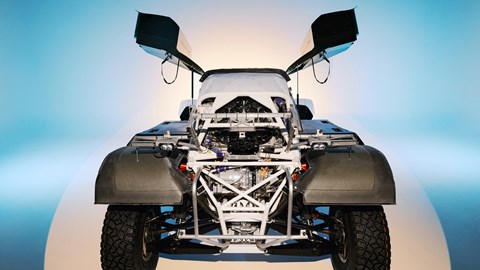► Extreme H takes the place of Extreme E
► Championship all use the new Pioneer 25
► 536bhp from two motors
Motorsport enters uncharted territory with the transformation of Extreme E into Extreme H, the world’s first motorsport series using only hydrogen fuel cell cars, aiming to prove that it’s a clean and viable alternative to battery electric or using hydrogen in combustion engines.
The car that will be raced by all the teams has just been revealed. Called Pioneer 25, it’s based on the Odyssey 21 that’s still in use in Extreme E’s fourth and final season, but is narrower and slightly heavier, with a lower centre of gravity.

The race format stays the same: each car is shared by one female and one male driver, swapping mid-race, with 12 races of about 10 minutes each taking place over a weekend. The off-road venues will be in Saudi Arabia, the UK, Germany, Italy and the USA – dates have yet to be confirmed, but the series starts in April.
Testing of Pioneer 25 began last December and has mostly taken place at venues in France favoured by Rally-Raid and World Rally Championship teams. It will continue at the Extreme E events in Scotland and Sardinia this summer.
Peak combined output from the two electric motors is 536bhp. There’s 332lb ft of torque, the 0-62mph sprint takes 4.5sec and top speed exceeds 125mph on tarmac.

The teams and drivers who will take part have not yet been confirmed, but it’s likely to involve many of the current Extreme E competitors. Series founder Alejandro Agag told us he wouldn’t expect any mainstream car manufacturers to be on board for the first year, but he hopes they will sign up for the second season, especially if they have a hydrogen fuel cell car on sale, when a ‘win on Sunday, sell on Monday’ logic could kick in.
But the main impetus was about proving what hydrogen could do.
‘Hydrogen is a technology, or a way to store energy, that still has so many challenges around it. It has some advantages, some disadvantages. In EVs, things were a lot further down the road when we started. In hydrogen, things are still at a very early stage: storing it, transporting it, fuelling it, using it in the cars,’ said Agag.
‘When we started this project two years ago, EVs were riding high, and I am the biggest advocate of EVs. But today there’s a moment of self-doubt on the EV wave, although the general trajectory is very strong. Today, so many more manufacturers are rethinking their hydrogen option. We are a platform for the technology.’

Series technical chief Mark Grain, formerly with McLaren, said: ‘Testing of this car has reminded me of when I was in F1. It’s an all new type of car. You’ve got to make a reliable car and you’ve got to make a fast car.
‘Hydrogen fuel cell is an all new element to motorsport globally. You couldn’t just take an Extreme E car and fit a fuel cell. The whole envelope where the fuel cell and battery sit, you look at that and revise that. And how the car will withstand impact: the roof design, the composite structures we’ve got protecting the tanks, the side impact, the lower impact.
‘There’s a lot of myths and rubbish spoken about hydrogen. Actually hydrogen is incredibly safe. We want to be able to demonstrate on all these demanding surfaces, big compressions, jumps, you can do all of that, race wheel-to-wheel, bang into each other, and it’s just another form of energy.
‘We are hopeful that we can demonstrate that hydrogen gas is viable and in no way posing any sort of danger or threat.’
Other race formats involving more than 10 minutes of action at a time would need more than the two kilos of hydrogen carried by an Extreme H car. That hydrogen creates electricity in the fuel cell, which passes through a battery pack that feeds the two e-motors.

Where is it all leading? Extreme H has regular meetings with motorsport’s governing body, the FIA, with other race series including Formula 1, and with car manufacturers and technology companies, to pool ideas: ‘We want to pass on our learning. And if they’re doing something in a test environment they want to share with us, perhaps we can help.’
Agag added: ‘Everyone has this feeling of getting into unchartered territory. This is a bit scary, but that’s what makes it interesting.’